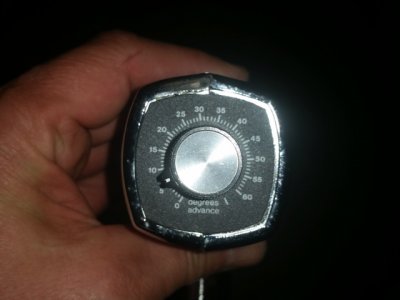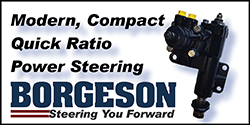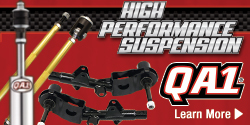Is this the article? if not ,This is a nice read.......
by Lars Grimsrud
SVE Automotive Restoration
Musclecar, Collector & Exotic Auto Repair & Restoration
Broomfield, CO Rev. B 8-19-02
Distributor Tuning and Theory - Part 1
There appears to be a lot of conversation on timing, vac advance, distributor tuning and, in general, hacking up a perfectly good ignition system to compensate for a poorly tuned carburetor.
The following two articles review the basics of distributor tuning quite well and have worked for years and years and are based on sound engineering principals. I thought it would be helpful for some to review these prior to hacking up their distributors. Hacking up your distributor to compensate for a poorly tuned, misapplied or defective carburetor is not very sound engineering, for a street application or otherwise.
Here's an interesting article on vacuum advance written by a GM engineer:
As many of you are aware, timing and vacuum advance is one of my favorite subjects, as I was involved in the development of some of those systems in my GM days and I understand it. Many people don't, as there has been very little written about it anywhere that makes sense, and as a result, a lot of folks are under the misunderstanding that vacuum advance somehow compromises performance. Nothing could be further from the truth. I finally sat down the other day and wrote up a primer on the subject, with the objective of helping more folks to understand vacuum advance and how it works together with initial timing and centrifugal advance to optimize all-around operation and performance. I have this as a Word document if anyone wants it sent to them - I've cut-and-pasted it here; it's long, but hopefully it's also informative.
TIMING AND VACUUM ADVANCE 101
The most important concept to understand is that lean mixtures, such as at idle and steady highway cruise, take longer to burn than rich mixtures; idle in particular, as idle mixture is affected by exhaust gas dilution. This requires that lean mixtures have "the fire lit" earlier in the compression cycle (spark timing advanced), allowing more burn time so that peak cylinder pressure is reached just after TDC for peak efficiency and reduced exhaust gas temperature (wasted combustion energy). Rich mixtures, on the other hand, burn faster than lean mixtures, so they need to have "the fire lit" later in the compression cycle (spark timing retarded slightly) so maximum cylinder pressure is still achieved at the same point after TDC as with the lean mixture, for maximum efficiency.
The centrifugal advance system in a distributor advances spark timing purely as a function of engine rpm (irrespective of engine load or operating conditions), with the amount of advance and the rate at which it comes in determined by the weights and springs on top of the autocam mechanism. The amount of advance added by the distributor, combined with initial static timing, is "total timing" (i.e., the 34-36 degrees at high rpm that most SBC's like). Vacuum advance has absolutely nothing to do with total timing or performance, as when the throttle is opened, manifold vacuum drops essentially to zero, and the vacuum advance drops out entirely; it has no part in the "total timing" equation.
At idle, the engine needs additional spark advance in order to fire that lean, diluted mixture earlier in order to develop maximum cylinder pressure at the proper point, so the vacuum advance can (connected to manifold vacuum, not "ported" vacuum - more on that aberration later) is activated by the high manifold vacuum, and adds about 15 degrees of spark advance, on top of the initial static timing setting (i.e., if your static timing is at 10 degrees, at idle it's actually around 25 degrees with the vacuum advance connected). The same thing occurs at steady-state highway cruise; the mixture is lean, takes longer to burn, the load on the engine is low, the manifold vacuum is high, so the vacuum advance is again deployed, and if you had a timing light set up so you could see the balancer as you were going down the highway, you'd see about 50 degrees advance (10 degrees initial, 20-25 degrees from the centrifugal advance, and 15 degrees from the vacuum advance) at steady-state cruise (it only takes about 40 horsepower to cruise at 50mph).
When you accelerate, the mixture is instantly enriched (by the accelerator pump, power valve, etc.), burns faster, doesn't need the additional spark advance, and when the throttle plates open, manifold vacuum drops, and the vacuum advance can returns to zero, retarding the spark timing back to what is provided by the initial static timing plus the centrifugal advance provided by the distributor at that engine rpm; the vacuum advance doesn't come back into play until you back off the gas and manifold vacuum increases again as you return to steady-state cruise, when the mixture again becomes lean.
The key difference is that centrifugal advance (in the distributor autocam via weights and springs) is purely rpm-sensitive; nothing changes it except changes in rpm. Vacuum advance, on the other hand, responds to engine load and rapidly-changing operating conditions, providing the correct degree of spark advance at any point in time based on engine load, to deal with both lean and rich mixture conditions. By today's terms, this was a relatively crude mechanical system, but it did a good job of optimizing engine efficiency, throttle response, fuel economy, and idle cooling, with absolutely ZERO effect on wide-open throttle performance, as vacuum advance is inoperative under wide-open throttle conditions. In modern cars with computerized engine controllers, all those sensors and the controller change both mixture and spark timing 50 to 100 times per second, and we don't even HAVE a distributor any more - it's all electronic.
Now, to the widely-misunderstood manifold-vs.-ported vacuum aberration. After 30-40 years of controlling vacuum advance with full manifold vacuum, along came emissions requirements, years before catalytic converter technology had been developed, and all manner of crude band-aid systems were developed to try and reduce hydrocarbons and oxides of nitrogen in the exhaust stream. One of these band-aids was "ported spark", which moved the vacuum pickup orifice in the carburetor venturi from below the throttle plate (where it was exposed to full manifold vacuum at idle) to above the throttle plate, where it saw no manifold vacuum at all at idle. This meant the vacuum advance was inoperative at idle (retarding spark timing from its optimum value), and these applications also had VERY low initial static timing (usually 4 degrees or less, and some actually were set at 2 degrees AFTER TDC). This was done in order to increase exhaust gas temperature (due to "lighting the fire late") to improve the effectiveness of the "afterburning" of hydrocarbons by the air injected into the exhaust manifolds by the A.I.R. system; as a result, these engines ran like crap, and an enormous amount of wasted heat energy was transferred through the exhaust port walls into the coolant, causing them to run hot at idle - cylinder pressure fell off, engine temperatures went up, combustion efficiency went down the drain, and fuel economy went down with it.
If you look at the centrifugal advance calibrations for these "ported spark, late-timed" engines, you'll see that instead of having 20 degrees of advance, they had up to 34 degrees of advance in the distributor, in order to get back to the 34-36 degrees "total timing" at high rpm wide-open throttle to get some of the performance back. The vacuum advance still worked at steady-state highway cruise (lean mixture = low emissions), but it was inoperative at idle, which caused all manner of problems - "ported vacuum" was strictly an early, pre-converter crude emissions strategy, and nothing more.
What about the Harry high-school non-vacuum advance polished billet "whizbang" distributors you see in the Summit and Jeg's catalogs? They're JUNK on a street-driven car, but some people keep buying them because they're "race car" parts, so they must be "good for my car" - they're NOT. "Race cars" run at wide-open throttle, rich mixture, full load, and high rpm all the time, so they don't need a system (vacuum advance) to deal with the full range of driving conditions encountered in street operation. Anyone driving a street-driven car without manifold-connected vacuum advance is sacrificing idle cooling, throttle response, engine efficiency, and fuel economy, probably because they don't understand what vacuum advance is, how it works, and what it's for - there are lots of long-time experienced "mechanics" who don't understand the principles and operation of vacuum advance either, so they're not alone.
Vacuum advance calibrations are different between stock engines and modified engines, especially if you have a lot of cam and have relatively low manifold vacuum at idle. Most stock vacuum advance cans aren’t fully-deployed until they see about 15” Hg. Manifold vacuum, so those cans don’t work very well on a modified engine; with less than 15” Hg. at a rough idle, the stock can will “dither” in and out in response to the rapidly-changing manifold vacuum, constantly varying the amount of vacuum advance, which creates an unstable idle. Modified engines with more cam that generate less than 15” Hg. of vacuum at idle need a vacuum advance can that’s fully-deployed at least 1”, preferably 2” of vacuum less than idle vacuum level so idle advance is solid and stable; the Echlin #VC-1810 advance can (about $10 at NAPA) provides the same amount of advance as the stock can (15 degrees), but is fully-deployed at only 8” of vacuum, so there is no variation in idle timing even with a stout cam.
For peak engine performance, driveability, idle cooling and efficiency in a street-driven car, you need vacuum advance, connected to full manifold vacuum. Absolutely. Positively. Don't ask Summit or Jeg's about it – they don’t understand it, they're on commission, and they want to sell "race car" parts.
Part 2
Distributor Vacuum Advance Control units
Specs and facts for GM Distributors
by Lars Grimsrud
SVE Automotive Restoration
Musclecar, Collector & Exotic Auto Repair & Restoration
Broomfield, CO Rev. B 8-19-02
I’ve been seeing a lot of discussion and questions regarding distributor vacuum advance control units; what do they do, which ones are best, what was used on what, etc., etc. To clarify some of this, I thought I’d summarize a few facts and definitions, and provide a complete part number and specification listing for all vacuum advance control units used by Chevrolet on the points-style distributors. I’m also providing a listing of the specs for all other GM (non-Chevrolet) control units, but without the specific application listed for each (it would take me a bit too much time to research each part number by application across each of the GM Motor Divisions – it took me long enough to compile just the Chevy stuff…!). This latest revision to this paper also includes the HEI listings (the HEI distributors use a longer control unit, so the non-HEI and HEI vacuum advance control units CANNOT be interchanged).
As always, I’m going to include the disclaimer that many of these are my own comments and opinions based on my personal tuning experience. Others may have differing opinions & tuning techniques from those presented here. I have made every attempt to present factual, technically accurate data wherever possible. If you find factual errors in this information, please let me know so I can correct it.
Background
The vacuum advance control unit on the distributor is intended to advance the ignition timing above and beyond the limits of the mechanical advance (mechanical advance consists of the initial timing plus the centrifugal advance that the distributor adds as rpm comes up) under light to medium throttle settings. When the load on the engine is light or moderate, the timing can be advanced to improve fuel economy and throttle response. Once the engine load increases, this “over-advance” condition must be eliminated to produce peak power and to eliminate the possibility of detonation (“engine knock”). A control unit that responds to engine vacuum performs this job remarkably well.
Most GM V8 engines (not including “fast-burn” style heads), and specifically Chevys, will produce peak torque and power at wide open throttle with a total timing advance of 36 degrees (some will take 38). Also, a GM V8 engine, under light load and steady-state cruise, will accept a maximum timing advance of about 52 degrees. Some will take up to 54 degrees advance under these conditions. Once you advance the timing beyond this, the engine/car will start to “chug” or “jerk” at cruise due to the over-advanced timing condition. Anything less than 52 degrees produces less than optimum fuel economy at cruise speed.
The additional timing produced by the vacuum advance control unit must be tailored and matched to the engine and the distributor’s mechanical advance curve. The following considerations must be made when selecting a vacuum advance spec:
How much engine vacuum is produced at cruise? If max vacuum at cruise, on a car with a radical cam, is only 15 inches Hg, a vacuum advance control unit that needs 18 inches to peg out would be a poor selection.
How much centrifugal advance (“total timing”) is in effect at cruise rpm? If the distributor has very stiff centrifugal advance springs in it that allow maximum timing to only come in near red-line rpm, the vacuum advance control unit can be allowed to pull in more advance without the risk of exceeding the 52-degree maximum limit. If the engine has an advance curve that allows a full 36-degree mechanical advance at cruise rpm, the vacuum advance unit can only be allowed to pull in 16 more degrees of advance.
Are you using “ported” or “manifold” vacuum to the distributor? “Ported” vacuum allows little or no vacuum to the distributor at idle. “Manifold” vacuum allows actual manifold vacuum to the distributor at all times.
Does your engine require additional timing advance at idle in order to idle properly? Radical cams will often require over 16 degrees of timing advance at idle in order to produce acceptable idle characteristics. If all of this initial advance is created by advancing the mechanical timing, the total mechanical advance may exceed the 36-degree limit by a significant margin. An appropriately selected vacuum advance unit, plugged into manifold vacuum, can provide the needed extra timing at idle to allow a fair idle, while maintaining maximum mechanical timing at 36. A tuning note on this: If you choose to run straight manifold vacuum to your vacuum advance in order to gain the additional timing advance at idle, you must select a vacuum advance control unit that pulls in all of the advance at a vacuum level 2” below (numerically less than) the manifold vacuum present at idle. If the vacuum advance control unit is not fully pulled in at idle, it will be somewhere in its mid-range, and it will fluctuate and vary the timing while the engine is idling. This will cause erratic timing with associated unstable idle rpm. A second tuning note on this: Advancing the timing at idle can assist in lowering engine temperatures. If you have an overheating problem at idle, and you have verified proper operation of your cooling system components, you can try running manifold vacuum to an appropriately selected vacuum advance unit as noted above. This will lower engine temps, but it will also increase hydrocarbon emissions on emission-controlled vehicles.
Thus, we see that there are many variables in the selection of an appropriate control unit. Yet, we should keep in mind that the control unit is somewhat of a “finesse” or “final tuning” aid to obtain a final, refined state of tune; we use it to just “tweak” the car a little bit to provide that last little bit of optimization for drivability and economy. The vacuum advance unit is not used for primary tuning, nor does it have an effect on power or performance at wide open throttle.
With these general (and a little bit vague, I know…) concepts in mind, let’s review a few concepts and terms. Then it’s on to the master listing of specs and parts…..:
Part Number
There are many different sources for these control units. Borg Warner, Echlin, Wells, and others all sell them in their own boxes and with their own part numbers. Actually, there are very few manufacturers of the actual units: Dana Engine Controls in Connecticut manufactures the units for all three of the brands just mentioned, so it doesn’t make much difference who you buy from: They’re made by the same manufacturer. The part numbers I have listed here are the NAPA/Echlin part numbers, simply because they are available in any part of the country.
ID#
Every vacuum advance control unit built by Dana, and sold under virtually any brand name (including GM), has a stamped ID number right on top of the mounting plate extension. This ID, cross referenced below, will give you all specifications for the unit. So now, when you’re shopping in a junkyard, you’ll be able to quickly identify the “good” vs. the “bad” control units.
Starts @ “Hg
Vacuum is measured in “inches of Mercury.” Mercury has the chemical symbol “Hg.” Thus, manifold vacuum is measured and referred to as “Hg. The “Start” spec for the control unit is a range of the minimum vacuum required to get the control unit to just barely start moving. When selecting this specification, consideration should be made to the amount of vacuum that a given engine produces, and what the load is on the engine at this specification. For example, an engine with a very radical cam may be under very light load at 7 inches Hg, and can tolerate a little vacuum advance at this load level. Your mom’s Caprice, on the other hand, has such a mild cam that you don’t want the vacuum to start coming in until 9 – 10 inches Hg. For most street driven vehicle performance applications, starting the vacuum advance at about 8” Hg produces good results.
Max Advance
Since the vacuum advance control unit is a part of the distributor, the number of degrees of vacuum advance is specified in DISTRIBUTOR degrees – NOT crankshaft degrees. When talking about these control units, it is important that you know whether the person you’re talking to is referring to the distributor degrees, or if he’s talking crankshaft degrees. All of the listings shown in the following chart, and in any shop manual & technical spec sheet, will refer to distributor degrees of vacuum advance. You must DOUBLE this number to obtain crankshaft degrees (which is what you “see” with your timing light). Thus, a vacuum advance control unit with 8 degrees of maximum advance produces 16 degrees of ignition advance in relationship to the crankshaft. When selecting a unit for max advance spec, the total centrifugal timing at cruise must be considered. Thus, a car set up to produce 36 degrees of total mechanical advance at 2500 rpm needs a vacuum advance control unit producing 16 degrees of crankshaft advance. This would be an 8-degree vacuum advance control unit.
Max Advance @ “Hg
This is the range of manifold vacuum at which the maximum vacuum advance is pegged out. In selecting this specification, you must consider the vacuum produced at cruise speed and light throttle application. If your engine never produces 20” Hg, you better not select a control unit requiring 21” Hg to work.
















